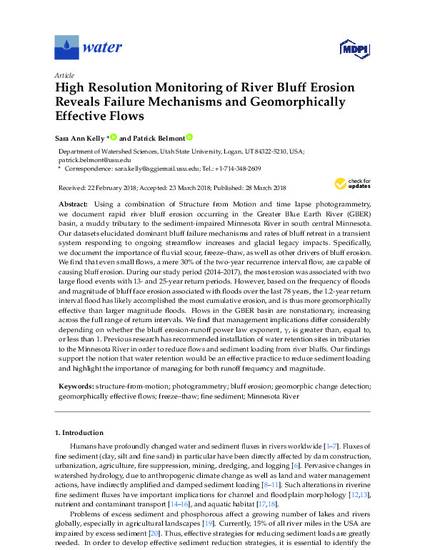
- structure-from-motion,
- photogrammetry,
- bluff erosion,
- geomorphic change detection,
- geomorphically effective flows,
- freeze–thaw,
- fine sediment,
- Minnesota River
Using a combination of Structure from Motion and time lapse photogrammetry, we document rapid river bluff erosion occurring in the Greater Blue Earth River (GBER) basin, a muddy tributary to the sediment-impaired Minnesota River in south central Minnesota. Our datasets elucidated dominant bluff failure mechanisms and rates of bluff retreat in a transient system responding to ongoing streamflow increases and glacial legacy impacts. Specifically, we document the importance of fluvial scour, freeze–thaw, as well as other drivers of bluff erosion. We find that even small flows, a mere 30% of the two-year recurrence interval flow, are capable of causing bluff erosion. During our study period (2014–2017), the most erosion was associated with two large flood events with 13- and 25-year return periods. However, based on the frequency of floods and magnitude of bluff face erosion associated with floods over the last 78 years, the 1.2-year return interval flood has likely accomplished the most cumulative erosion, and is thus more geomorphically effective than larger magnitude floods. Flows in the GBER basin are nonstationary, increasing across the full range of return intervals. We find that management implications differ considerably depending on whether the bluff erosion-runoff power law exponent, γ, is greater than, equal to, or less than 1. Previous research has recommended installation of water retention sites in tributaries to the Minnesota River in order to reduce flows and sediment loading from river bluffs. Our findings support the notion that water retention would be an effective practice to reduce sediment loading and highlight the importance of managing for both runoff frequency and magnitude.
Available at: http://works.bepress.com/patrick_belmont/165/
